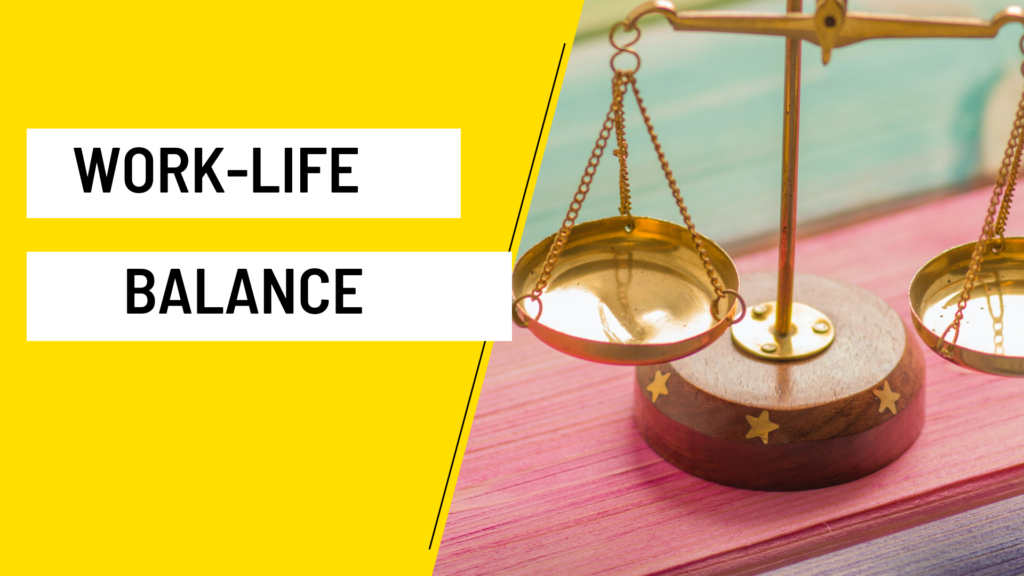Work-Life Balance

In today’s fast-paced world, achieving a harmonious balance between work and personal life has become increasingly challenging. The constant demands of work, coupled with personal commitments, often leave individuals feeling overwhelmed and burnt out. However, prioritizing work-life balance is essential for overall well-being and long-term success. In this article, we’ll explore the concept of work-life balance, its significance, and practical strategies to achieve it.
Understanding Work-Life Balance:
Work-life balance refers to the equilibrium between the time and energy allocated to work-related activities and those dedicated to personal pursuits, leisure, and family time. It involves effectively managing professional responsibilities while nurturing personal relationships, pursuing hobbies, and maintaining physical and mental health. Achieving work-life balance doesn’t necessarily mean equal time allocation to work and personal life but rather finding a sustainable equilibrium that promotes overall happiness and fulfillment.
Significance of Work-Life Balance:
A healthy work-life balance is crucial for several reasons. Firstly, it enhances overall well-being by reducing stress levels and preventing burnout. Continuous exposure to work-related stress without adequate relaxation and personal time can lead to physical and mental health issues such as anxiety, depression, and cardiovascular problems. Secondly, maintaining a balance between work and personal life improves productivity and job satisfaction. When individuals feel fulfilled in their personal lives, they bring a positive attitude and higher levels of engagement to their professional roles. Lastly, prioritizing work-life balance fosters stronger relationships with family and friends, contributing to a fulfilling personal life.
Practical Strategies for Achieving Work-Life Balance:
Achieving work-life balance requires intentional effort and a commitment to self-care. Here are some practical strategies to help individuals attain this balance:
Establish Boundaries:
Set clear boundaries between work and personal life. Define specific work hours and stick to them, avoiding the temptation to overwork or bring work-related tasks into personal time.
Prioritize Tasks:
Practice effective time management by prioritizing tasks based on urgency and importance. Identify critical tasks that require immediate attention and allocate time for them accordingly, leaving room for personal activities.
Learn to Delegate:
Recognize when it’s appropriate to delegate tasks at work or enlist support from family members for household chores. Delegating responsibilities allows for more time to focus on high-priority tasks and personal interests.
Take Regular Breaks:
Incorporate regular breaks into your workday to recharge and prevent burnout. Short breaks can help improve focus and productivity while reducing stress levels.
Practice Mindfulness:
Incorporate mindfulness practices into your daily routine, such as meditation, deep breathing exercises, or yoga. These techniques can help reduce stress, increase self-awareness, and promote a sense of balance and clarity.
Set Realistic Goals:
Set achievable goals for both work and personal life. Break larger goals into smaller, manageable tasks, and celebrate progress along the way. Setting realistic expectations reduces pressure and prevents feelings of inadequacy.
Limit Screen Time:
Reduce screen time outside of work hours, particularly on electronic devices such as smartphones, tablets, and computers. Instead, allocate time for activities that promote relaxation and social connection, such as reading, outdoor walks, or spending time with loved ones.
Nurture Relationships:
Prioritize spending quality time with family and friends. Schedule regular activities or outings to strengthen relationships and create lasting memories outside of work obligations.
Practice Self-Care:
Make self-care a priority by engaging in activities that promote physical, emotional, and mental well-being. This may include exercising regularly, eating a balanced diet, getting adequate sleep, and engaging in hobbies or activities that bring joy and fulfillment.
Seek Support:
Don’t hesitate to seek support from colleagues, friends, or professional counselors if you’re feeling overwhelmed or struggling to maintain balance. Talking openly about your challenges can provide valuable insights and support.
Conclusion:
Achieving work-life balance is an ongoing journey that requires conscious effort and prioritization. By implementing practical strategies such as setting boundaries, prioritizing tasks, practicing mindfulness, and nurturing relationships, individuals can cultivate a sense of equilibrium between their professional and personal lives. Remember that achieving work-life balance is not about perfection but rather about finding a sustainable balance that promotes overall well-being and fulfillment. By prioritizing self-care and fostering meaningful connections, individuals can lead happier, more fulfilling lives both inside and outside the workplace.





